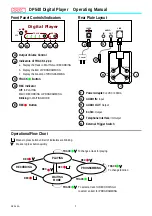
WAVECOM Decoder W74PC, W-PCI/e, W-CODE, W-CLOUD Manual V9.1.0
WAVECOM Data Formats
331
used in files should be indicated using the SOFH chunk. The format name may also be used for the
file extension to allow visual discrimination of different files.
State information is accumulated by an application by reading different chunks sequentially. If
synchronization is lost, state information needs to be reset. This is why it is essential to resend
meta data every second.
It is necessary to be able to distinguish between continuous data and block data where only part
of the time data is available. Data chunks contain timestamps to enable detection of discontinui-
ties. A chunk has also been defined to indicate discontinuities in the time data, namely the "IQDC"
chunk.
Playback control is essential for the off-line analysis of files, however due to the stream based de-
sign of the PXGF format, playback control is not easily supported. The PXGF format uses data
chunks supported by a number of meta chunks that describe the state of the data stream. Before
processing data chunks it is necessary to obtain sufficient state information, like the sample rate,
by processing the necessary chunks in the data stream. The use of an index file has been pro-
posed as a possible solution to the problem of playback control. By reading an index file an appli-
cation could determine over what period the recording was made and determine where to start
processing the stream to play back a particular section.
C++ and Java libraries have been developed for the writing and reading of PXGF streams. The li-
braries take care of synchronization and formatting issues; they do not provide or dictate the
communication medium.
The PXGF streaming format does not provide any mechanism for communication between the
source of the data stream and the application receiving the data stream. The PXGF stream there-
fore represents a unidirectional flow of information from the source to the sink of the stream.
Applications that process PXGF input streams should not make assumptions about the data. For
example, if the sample data were being sent using the SSIQ chunk the application should wait for
a SIQP chunk to determine the packing of the data rather than assuming a particular packing.
DEFINITION OF CHUNKS
Single channel Short IQ time data
–
SSIQ chunk
Data is assumed to be continuous when using this data format, if the data is blocky, an IQDC chunk must
be sent after every block of continuous data.
Element
Type
Description
lTimestamp
int64
The timestamp is stored as a 64 bit signed number, representative of the
time of capture of the first sample in the chunk block, in microsecond
resolution. It is stored as the number of microseconds since beginning of
the epoch (i.e., 1st January 1970 midnight).
awIQData
int16 [length
of IQ data ar-
ray]
IQ pairs of signed int16 short numbers. Note that regardless of the
number of valid bits, the most significant bits in each short should be
used. This allows us to specify the full-scale level without needing to
specify the number of bits.
Single channel Float IQ time data
–
SFIQ chunk
Data is assumed to be continuous when using this data format, if the data is blocky, an IQDC chunk must
be sent after every block of continuous data.
Element
Type
Description
lTimestamp
int64
The timestamp is stored as a 64 bit signed number, representative of the
time of capture of the first sample in the chunk block, in microsecond
resolution. It is stored as the number of microseconds since beginning of
the epoch (i.e., 1st January 1970 midnight).
awIQData
Float32
[length of IQ
data array]
IQ pairs of float32 numbers.
















































